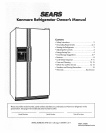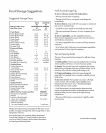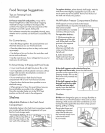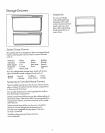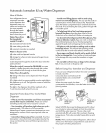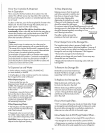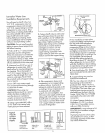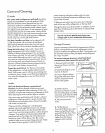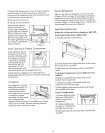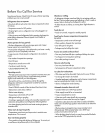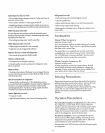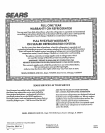
Care and Cleaning
Outside
The water and ice dispenser spill shelf should be
wiped dry immediately to prevent spotting. Water
left on the shelf may leave deposits that you can
remove by soaking in undiluted vinegar You can also
use a paste of non-precipitating water softener (such
as Calgon brand) and water, or one teaspoon of citric
acid powder per pint of hot tap water.. Soak until the
deposit disappears or becomes bose enough to rinse
away. Usually 30 minutes soaking time is adequate
Avoid using wax on the spill shetf and trim
The door handles and trim can Be cleaned with
a cloth dampened with a solution of mild liquid
dishwashing detergent and water_ Dry with a soft
cloth Don't use wax on the door handles and trim.
Keep the finish clean_ Wipe with a clean cloth
lightly dampened with kitchen appliance wax or
mild liquid dishwashing detergent Dry and polish
with a clean, soft cloth Do not wipe the refrigerator
with a soiled dishwashing cloth or wet towel, These
may leave a residue that can harm the paint. Do not
use scouring pads, powdered cleaners, bleach or
cleaners containing bleach because these products
can scratch and weaken the paint finish
Protect the paint flnish_ The finish on _heoutside
of the refrigerator is a high quality, baked-on paint
finish With proper care, it w_ll stay new-!ooking and
rust-free for years. Apply a coat of kitchen/appliance
wax when the refrigerator is new and then at least
twice a year
Inside
The fresh food and freezer compartment
interiors should be cleaned at least once a year_
Unplug the refrigerator before cleaning If this is not
practical, wring excess moisture out of sponge or cloth
when cleaning around switches, lights or controls
Use warm water and baking soda solution-about a
tablespoon of baking soda to a quart of water This
both cleans and neutralizes odors. Rinse thoroughly
with water and wipe dry
Other parts of the refrigerator-including door
gaskets, meat and vegetable drawers, ice storage
bin and aLtplastic parts-can be cleaned the same
way Do not use cleansing powders or other abrasive
cleaners. Door gaskets are factory-lubricated with
petroleum jeIty on the hinge side. If the Iubricant is
excessive, wipe it off but leave a thin film an the
gasket to help insure a proper hinge_side seal. When
you clean the door gaskets, relubricate them
Avoid cleaning cold glass shelves with hot water
because the extreme temperature difference may
cause them to break
To help prevent odors, leave an open box of baking
soda in the rear of the refrigerator, on the top shelf
Change the box every three months _naddition, put an
open box of baking soda in the freezer to absorb stale
freezer odors
Do not wash any plastic parts from your
refrigerator in your automatic dishwasher.
Storage Drawers
Drawers at bottom of Freshfood compartment will stop
before coming all the way out of refrigerator to help
prevent contents from spilling onto floor The drawers can
be removed easily by tilting up slightly and pu!ling past
the "stop" iocafion
To remove storage drawers when fresh food
compartment door cannot be opened fully:
1. Remove food from shelf
above top drawer and take
out shelf.
20Take food off glass cover
and out of drawerr
3. Put your fingers behind
the gasket at the rear of the
drawer and pull forward
Remove the gasket
4. Pull the drawer
partway out. Reach in, push
the rear of the glass up; at the
same time, push it back until it
clears front-corner retainers
5_ Tilt and remove the
cover,
60 Pull the drawer
forward, lift the front to dear
stops, and pull the drawer
out until it hits the door. Then
Jiltthe drawer up until it is
higher than the drawer
supports, tilt itand take
it ouL
12



